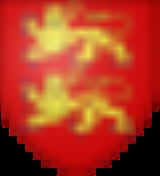
Écrainville
Encyclopedia
Écrainville is a commune
in the Seine-Maritime
department in the Haute-Normandie
region
in northern France
.
, situated some 13 miles (20.9 km) northeast of Le Havre
, at the junction of the D68 and D139 roads.
and even earlier. Abbé Dicquemare described, in 1778, the 150 human skeletons found in the crypt at the former quarry
at Maucomble at Val-Miellé, and suggests that the crypt was prior to the 11th century, as the church of Saint-Denis dates from that period.
The first written mention of Écrainville or one of its hamlets dates back in the late 11th century. In 1180, the lord of Tennemare or Tannemare appeared in the records of the Exchequer of Normandy. Until the 17th century, the seigneurie
passed from father to son of the Folville family.
A decree of 25 October 1826 joined Tennemare and Écrainville as one commune. In the 19th century the textile industry was still flourishing but declined from the 1920s onward.
Communes of France
The commune is the lowest level of administrative division in the French Republic. French communes are roughly equivalent to incorporated municipalities or villages in the United States or Gemeinden in Germany...
in the Seine-Maritime
Seine-Maritime
Seine-Maritime is a French department in the Haute-Normandie region in northern France. It is situated on the northern coast of France, at the mouth of the Seine, and includes the cities of Rouen and Le Havre...
department in the Haute-Normandie
Haute-Normandie
Upper Normandy is one of the 27 regions of France. It was created in 1984 from two départements: Seine-Maritime and Eure, when Normandy was divided into Lower Normandy and Upper Normandy. This division continues to provoke controversy, and some continue to call for reuniting the two regions...
region
Régions of France
France is divided into 27 administrative regions , 22 of which are in Metropolitan France, and five of which are overseas. Corsica is a territorial collectivity , but is considered a region in mainstream usage, and is even shown as such on the INSEE website...
in northern France
France
The French Republic , The French Republic , The French Republic , (commonly known as France , is a unitary semi-presidential republic in Western Europe with several overseas territories and islands located on other continents and in the Indian, Pacific, and Atlantic oceans. Metropolitan France...
.
Geography
A farming commune made up of 11 villages and hamlets in the Pays de CauxPays de Caux
The Pays de Caux is an area in Normandy occupying the greater part of the French département of Seine Maritime in Haute-Normandie. It is a chalk plateau to the north of the Seine Estuary and extending to the cliffs on the English Channel coast - its coastline is known as the Côte d'Albâtre...
, situated some 13 miles (20.9 km) northeast of Le Havre
Le Havre
Le Havre is a city in the Seine-Maritime department of the Haute-Normandie region in France. It is situated in north-western France, on the right bank of the mouth of the river Seine on the English Channel. Le Havre is the most populous commune in the Haute-Normandie region, although the total...
, at the junction of the D68 and D139 roads.
History
The origin of the name is uncertain, but Escrainvilla is first mentioned at the end of the 12th century. Many documents trace the occupation of the territory at the time of the FranksFranks
The Franks were a confederation of Germanic tribes first attested in the third century AD as living north and east of the Lower Rhine River. From the third to fifth centuries some Franks raided Roman territory while other Franks joined the Roman troops in Gaul. Only the Salian Franks formed a...
and even earlier. Abbé Dicquemare described, in 1778, the 150 human skeletons found in the crypt at the former quarry
Quarry
A quarry is a type of open-pit mine from which rock or minerals are extracted. Quarries are generally used for extracting building materials, such as dimension stone, construction aggregate, riprap, sand, and gravel. They are often collocated with concrete and asphalt plants due to the requirement...
at Maucomble at Val-Miellé, and suggests that the crypt was prior to the 11th century, as the church of Saint-Denis dates from that period.
The first written mention of Écrainville or one of its hamlets dates back in the late 11th century. In 1180, the lord of Tennemare or Tannemare appeared in the records of the Exchequer of Normandy. Until the 17th century, the seigneurie
Fiefdom
A fee was the central element of feudalism and consisted of heritable lands granted under one of several varieties of feudal tenure by an overlord to a vassal who held it in fealty in return for a form of feudal allegiance and service, usually given by the...
passed from father to son of the Folville family.
A decree of 25 October 1826 joined Tennemare and Écrainville as one commune. In the 19th century the textile industry was still flourishing but declined from the 1920s onward.
Population
Places of interest
- The church of St.Denis, dating from the eleventh century.
- A seventeenth century inn.
- The medieval manorhouse at Groseillers.
- The château d'Ecrainville.

